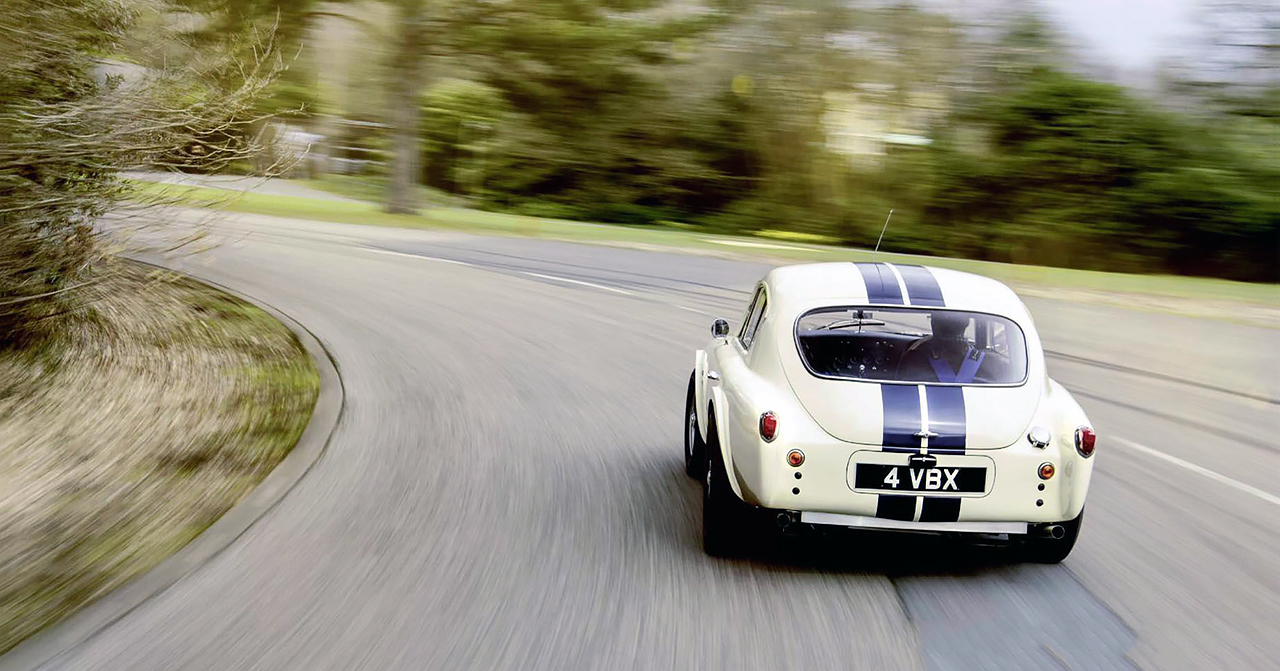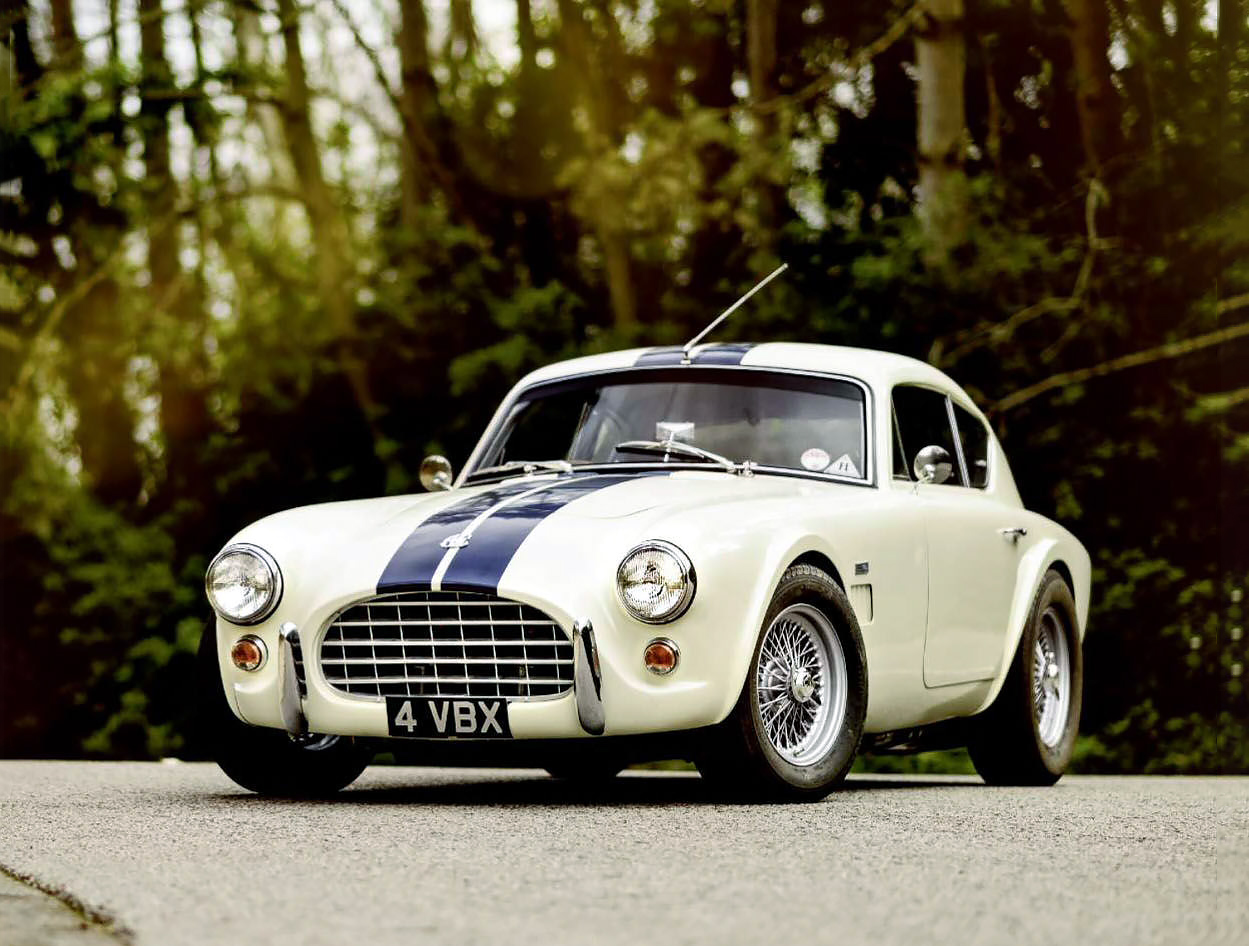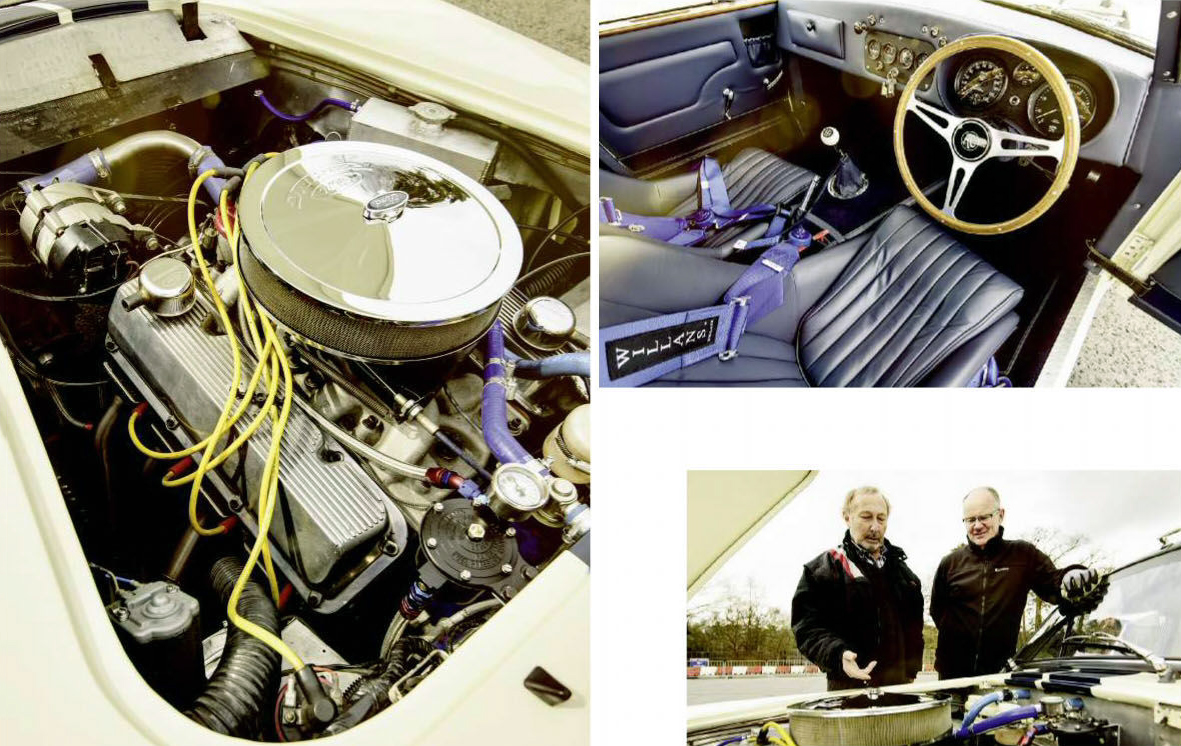
AC Aceca We get very sideways in the bellowing, tyre-shredding monster that AC never got around to building – a 5.0-litre V8-engined Aceca It may look like a subtly modified Aceca, but this unique AC is not all that it seems. Beneath the bonnet lurks a 400bhp V8… Words Ivan Ostrof. Photography Patrik Lindgren.
I look down the long strip of tarmac ahead and move the gearlever into first. Slamming my right foot down, I drop the clutch, setting the rear Avons spinning and howling. The engine note changes from a deep-throated growl to a continuous ‘graaaaaaaaahhhh’ as the tachometer spins around to 5000rpm and the limited-slip diff does its stuff. In what seems like a nanosecond I’m 200 yards down the road with a pair of thick black lines marking my breakneck progress. I change up and the car crabs sideways, but it’s easy to get back in line despite the fact that the wheels are still spinning. They stay spinning through to third when I ease off. Being less of a hooligan and balancing wheelspin against traction is probably the preferred approach if you want the ultimate in arm-wrenching performance, but either way this AC accelerates like no Aceca I’ve ever driven.
That’s because this AC is not as it originally rolled out of the firm’s Thames Ditton factory in the Sixties – it has the coupé style of the Aceca mated to Cobra-spec power and running gear. It’s a hybrid formed in the imagination of an enthusiast who wanted to create that glaring omission from AC’s range – an Aceca V8.
Above my head, the elegant Aceca roofline swoops back towards the tail, but under the broad bonnet the coupé’s usual powerplants – the 2.0-litre straight-six Bristol or AC engine – are conspicuous by their absence. There’s a genuine Ford Boss 4948cc (302ci) V8 in there, kicking out well over 400bhp. And examination of the bodywork reveals embellishments that hint at the transformation below the skin: Cobra MkII wheelarches, bonnet louvres and grilles on the sides of the front wings, along with Cobra-style chrome front over-riders. I’ve driven quite a few Cobras and always had a soft spot for them. I’ve also enjoyed the delights of the earlier, somewhat less powerful Ace roadster – from which the Cobra evolved – and its enclosed Aceca coupé variant. But this is very different, being at the same time neither one nor the other, but both.
The doors shut with that special subdued clunk that signifies meticulously hand-built aluminium coachwork. My hands sit perfectly on the wood-rimmed steering wheel, my feet fall nicely on the pedals. If I had the slightest doubt that I was sitting in an AC, the logo cast into the brake and clutch pedals puts that right. The dashboard, in blue leather to match the hide bucket seats, is clearly that of an AC Ace or Aceca, yet the central gearlever with its T-bar lift to guard against accidental selection of reverse gear is pure Cobra.
Once summoned into life, the engine shatters the morning stillness, with that familiar Ford V8 rumble pulsing from the twin exhaust pipes, one on each side of the tail. Nothing can beat the raw, basic grunt of a Detroit Ford V8 in my opinion– I can appreciate all other forms of the internal combustion engine, right up to the latest high-tech twincam Italian extravagance, but there’s something powerfully elemental about this classic configuration of American iron – it sounds like a predator at the top of the food chain as it relentlessly sucks in air through its four-barrel Holley downdraught carburettor.
The steering is noticeably weighty at parking speeds although it lightens up on the move, and the clutch is heavy – a familiar sensation when driving such a car with a big engine and manual gearbox.
Fortunately, years of driving old cars has developed my leg muscles and the gears feel relatively easy to select through the Hurst shifter.
I immediately enjoy the Aceca Cobra. The V8 is tuned to just the right level – there’s buckets of grunt, but it’s still a totally practical road car. In front of me the tachometer reads to a very optimistic 11,000rpm, but in reality the rev limit is more like 6500rpm. You certainly wouldn’t want to pull much over seven if you want the engine to have reliable longevity – and as maximum torque is developed at around 4500rpm there’s little point in taking it above six.
At speed in a straight line it runs true and feels like a factory-built Sixties car. To be more precise, it feels and handles exactly like a Cobra MkIII – it’s built on a shortened AC 428 coil-sprung chassis with Cobra MkIII underpinnings, so that’s hardly a surprise. The main difference is that the relatively well insulated enclosed interior lulls you into believing that this is a docile, mild-mannered, Sixties cloth cap cruiser while driving on a light throttle. But don’t be fooled – depress the throttle a whisker more and it morphs into an absolute monster.
The 200mph speedometer has been sensibly marked at advisory change-up points: first to second at 50mph, into third at 70 and on to fourth at 110. If you reckon that sounds tame, then think 0-60mph in 4.5 seconds and 0-100 in 10.5 to get things into perspective. Regarding maximum speed, the car will be closing in on 170mph by the time it tops out. But before I start to push it I pull over to adjust the Willans full harness and ponder the history of this fascinating hybrid.
The Aceca was built between the mid-Fifties and early Sixties. It’s the two-door coupé version of the open Ace, both cars having been developed for AC by John Tojeiro from his earlier, highly successful Tojeiro Bristol sports racing car. The Aceca’s stylish two-seater bodywork offered extra carrying space, which made it an ideal sports grand tourer. Both the Ace and Aceca proved popular for both road and competition use in the UK and the US.
The idea of a factory-produced V8-powered Aceca had been mooted, as Trevor Legate, author of Cobra: The First 40 Years, had explained to me earlier. ‘In 1961, the AC factory needed a new engine for the Ace, Aceca and Greyhound. The AC engine was by then long in the tooth and the Bristol unit was going out of production. Though Aces had been fitted with the straight-six out of the Ford Zephyr, at the time the AC company thought that unit somewhat mundane.
Derek Hurlock of AC Cars needed a straight-six or a compact V8, but none of the major manufacturers seemed willing to help. Apparently, Hurlock approached Jaguar-Daimler to acquire the Edward Turnerdesigned Daimler V8 2.5-litre engine for use in the Ace and Aceca, but was turned down flat.
‘By 1961 at least two Aces had been fitted with V8 engines from the Corvette in the US, so the factory knew that the combination worked. It was heavily rumoured that Ken Rudd (of Ruddspeed Engineering) dropped a Chevy V8 engine into an AC Ace or Aceca chassis and showed it to the factory, but the project failed following a major falling out between him and the AC management. As is now well known, the Cobra was born when Carroll Shelby entered into a contract to buy 100 cars from AC and fit them with Ford V8 engines. A lump of basic mundane Detroit iron it may have been, but money talks and it was an offer the tiny – and often struggling – Thames Ditton factory could not afford to refuse.
‘Although the AC factory did produce a special Le Mans coupé, John Willment Racing built two coupés – one road car and one racer – and Carroll Shelby built six Daytona Coupés. The factory never actually built an Aceca V8.. If they had, AC would almost certainly have ended up installing the Buick 3.5-litre V8.
‘Apparently an Aceca-style Cobra coupé was considered by Keith Judd at AC Cars in the Sixties, but being so pressured to produce Cobra chassis for Shelby, AC didn’t get around to dealing with it before production ceased.’
The man who finally brought the idea of a V8-powered Aceca to fruition was Werner Oswald, an AC enthusiast who lived in Switzerland in the early Eighties. He owned several Aces and Cobras along with at least a couple of Acecas with Bristol engines. He harboured a desire to produce the model that the AC factory never got round to and decided to address the unfinished business himself.
‘I happened to have all the right bits available at the time,’ Oswald explains, ‘so it seemed an obvious progression. I had a very rough Aceca without an engine or front axle, for which I paid just a few hundred Swiss francs and my brother had an AC 428 which had been rolled. Knowing the 428 chassis would certainly not require any strengthening or modification to accommodate the big Ford V8, I decided to use that to make my own Aceca Cobra.
‘I had an extremely good local panel beater who made up a jig so that the 428 chassis could be straightened perfectly before we shortened it. I then built the car with my friend George Weiner assisting with the installation of all the mechanical components. We fitted Cobra MkIII all-independent coil-spring and double-wishbone suspension, so we knew the spring rates were perfect from the beginning and everything was going to fit in the right place.
‘Finally the chassis was mounted with AC Aceca body number 558. I owned several Cobras and fancied having one with a Boss 302 V8 because it can be highly tuned but isn’t too heavy. So I fitted one with big-valve cylinder heads, a steel crankshaft and conrods and +0.03in pistons so the car was guaranteed to be as quick as any Cobra could be.’
Oswald fitted the Boss unit with the fourbarrel Holley carburettor topped by a 14-inch K&N air filter. Ignition was via a Mallory distributor assisted by an MSD electronic ignition system. Wisely, the gearbox chosen was a Richmond 4+1 five-speed unit so the 400bhp on tap could supply both searing acceleration and flexible, unstressed cruising performance.
‘The car was finished in about 1982 and I had immense fun driving it for several years,’ says Oswald. ‘When I went to live in the UK for the second time in my life, in 1982, I wanted to have the Aceca Cobra over there, so I got my friend George Weiner to drive the car over to England for me. Eventually I sold it in part payment for an Alfa Romeo 1750 – I think that was in 1987 or 1988. These days, I suppose there are some who might think this is an AC 428 and an Aceca ruined. At the time I felt I was giving those old components a new lease of life, while hopefully not offending any of the AC aficionados.’
He’s right that some will inevitably turn up their noses, but I would argue there are many fine classics with an accepted provenance despite going through a metamorphosis. The late Stanley Mann’s famous Bentley Mother Gun needed a new frame following a crash at Le Mans in 1927, and a reworked frame in 1928; it raced with a twoseater body at Brooklands, then had a single-seat chassis fitted in 1935 and currently wears a more recent single-seater body. Nevertheless, that vehicle has always been known as the Mother Gun.
Other changes to the Aceca include Aeroquip hoses throughout as well as competition cooling pipework, and latterly the car has been endowed with a built-in fire extinguisher system. Current keeper Nigel Hulme has had the interior completely retrimmed in dark blue hide, fitted high-quality blue carpets and had the bodywork repainted to a very high standard so the impression on first viewing is that this couldn’t be anything other than a factory-finished vehicle.
Back behind the wheel, I’m discovering that the Cobra MkIII disc brakes are progressive, slowing the car easily and confidently without the need for excessive pressure. The rack-and-pinion steering is precise and lets you know exactly what is going on at the sharp end. Interestingly, there is far less scuttle shake than there is in an Ace or a Cobra. With its immense 370lb ft of torque, I find that I can take even tight corners in third gear – but it’s much more fun to drop a cog and enter opposite-lock heaven.
It’s the same through the quicker bends, going slow in and fast out as I boot it through the apex and control the resultant yaw with my right foot. I have to stay alert, though – as brilliant as a car like this is to drive, it’s an unforgiving beast and will likely bite me so hard that I’ll be punching holes through hedgerows if I don’t stay focused. On the other hand, it feels like it will pull away in top gear with hardly any revs and stay there all day if I’m not in the mood to hustle. If I wanted to be lazy I could almost treat it like an automatic because there’s so much torque on tap. That’s big V8s for you, and one of many reasons why I adore cars like this.
Cobras always have a special appeal for me; unlike modern machines with all their electronic nannying they’re not cars that you’d take for granted. With all that power under your right foot every trip is a challenge – and even more so in this car. It has been referred to as the Boss Aceca in reference to its Ford V8, but I feel Aceca Cobra is far more fitting. Without doubt, this is the car that AC should have built.
‘At the time I felt I was giving those old components a new lease of life’

Cobra MkII wheelarches and bonnet louvres hint that something large lurks up front… Right top: …and here it is.

The Aceca carves serenely towards another apex before the driver depresses the throttle and all hell breaks loose.
‘There’s a 4948cc Ford Boss V8 under the bonnet, kicking out well over 400bhp’
LIVING WITH AN ACECA
Nigel Hulme has a long association with big V8-engined cars. Apart from racing Lola T70s for 33 years, he also owned and raced the Willment Racing AC Cobra 39PH at Goodwcod. This was the car famous for coming 7th overall and winning the GT Class in 1963 at Le Mans, as well as its ‘black flag’ race victory with Jack Sears at the helm in 1964. In 2007, having sold his Lola T70, Hulme was looking for something else to play with when he heard that Richard Dodkins was selling the Aceca Cobra.
Nigel says, ‘When I saw it, I thought it was such an elegant-looking car and yet quite different. Having owned Cobras, and running Le Mans Coupes (a firm specialising in continuation GT40s and Shelby Daytona Coupes) it also seemed rather apt to have a Cobra with a coupe body on it.
It required some restoration but was realty quite lovely, so I bought it, had it stripped back to bare aluminium, then repainted and re-trimmed it.’
Nigel has owned many other historic vehicles but his whole life has been around big V8 engine cars, and he has a great passion for them. This is a Sixties car, with a Sixties feel and Sixties handling.
I could buy a modern car with all the driver aids but I like cars you have to drive; cars with serious grunt that don’t necessarily behave perfectly but where you have to use your skills to make them go quickly. The Aceca Cobra is all that rolled into one.’

Owner Nigel (right) and Classic Cars’ Ivan talk V8s
TECHNICAL DATA 1982 Aceca Cobra
Engine 4948cc V8, ohv, four-barrel Holley downdraught carburetor
Power and torque: 425bhp @ 5800rpm; 370lb ft @ 4500rpm
Transmission Richmond 4+1 five-speed manual, rear-wheel drive
Suspension All independent, double wishbones and coil springs with adjustable dampers, front anti-roll bar
Steering Rack and pinion
Brakes Discs front and rear
Length 4064mm
Width 1550mm
Weight 1040kg
Performance 0-60mph: 4 5sec; top speed: 165mph-plus





